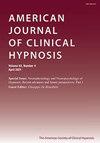Editorial.
IF 1.2
4区 心理学
Q3 PSYCHOLOGY, CLINICAL
引用次数: 0
Abstract
As this issue of the American Journal of Clinical Hypnosis (AJCH) goes to press, I am again reminded of how frequently the concepts of hypnosis and treatment are conflated. To spell this out more specifically, many professionals in the United States and outside our country either have a mental shorthand for therapeutic communication and treatment conducted during hypnosis or think hypnosis is, by itself, a treatment intervention. The former may seem somewhat understandable, especially when speaking to other well-informed therapists. For those situations, our colleagues know that hypnosis is used as a context in which our therapeutic communication and interventions are delivered. So, the casual comment, “I used hypnosis to treat four patients today,” should convey the idea that treatment was conducted with four patients who were in hypnosis (or in a hypnotic trance, or in a trance state, etc., depending on your customary manner of stating it). However, the statement should not carry the meaning that hypnosis was the treatment intervention used. Hypnosis is not a treatment. To imply such would be the equivalent of a surgeon or dentist saying, “Today I used general anesthesia to treat four patients.” Surely, no intelligent listener would assume that a surgery or extractions occurred because of the anesthesia. One would assume there must have been a medical or dental intervention following the alteration of consciousness created by the anesthesia. However, we must not assume that listeners, whether they are clients, patients, the lay public, or trained professionals, make a similar leap of understanding when they hear, “I treated them with hypnosis.” Furthermore, authors attempting to share successful case reports and describe research procedures fall short in their manuscripts with such truncated descriptions as, “hypnosis was used.” AJCH is a hypnosis journal: As readers, we understand that treatment is being conducted in the context of hypnosis. And, we understand that research is studying the efficacy of interventions being delivered during hypnosis (and often compared to the same interventions delivered without hypnosis). Nevertheless, it should be clearly stated that therapy is the result of communicating the intervention process during hypnosis. Manuscripts should not take short cuts or use colloquialisms that might convey to readers the idea that hypnosis was the intervention. Hypnosis is a context that can be used to present or deliver therapeutic communications and thoughtful interventions. I frequently explain this idea as follows: Assembling people in a group is not therapy; talking to a family gathering is not therapy; talking face to face to a person is not therapy; talking to someone in hypnosis is not therapy. These are simply various contexts for communicating with others. And in any of these contexts, therapeutic communication and treatment interventions can be delivered. When that is accomplished, professionals refer to the event as “group therapy,” “family therapy,” “individual therapy,” or “hypnotherapy.” And, in the latter case, it may be preferable to say, “therapy during hypnosis” and not “hypnotherapy.” Why? Because, as practitioners, we want to be accurate professionals and attempt to educate the public and other health-care professionals that hypnosis is not, itself, AMERICAN JOURNAL OF CLINICAL HYPNOSIS 2022, VOL. 65, NO. 2, 83–86 https://doi.org/10.1080/00029157.2022.2105082社论。
本文章由计算机程序翻译,如有差异,请以英文原文为准。
求助全文
约1分钟内获得全文
求助全文
来源期刊

American Journal of Clinical Hypnosis
PSYCHOLOGY, CLINICAL-
CiteScore
2.00
自引率
23.10%
发文量
52
期刊介绍:
The American Journal of Clinical Hypnosis ( AJCH) is the official publication of the American Society of Clinical Hypnosis (ASCH). The Journal publishes original scientific articles and clinical case reports on hypnosis, as well as books reviews and abstracts of the current hypnosis literature. The purview of AJCH articles includes multiple and single case studies, empirical research studies, models of treatment, theories of hypnosis, and occasional special articles pertaining to hypnosis. The membership of ASCH and readership of AJCH includes licensed health care professionals and university faculty in the fields of medicine, psychiatry, clinical social work, clinical psychology, dentistry, counseling, and graduate students in these disciplines. AJCH is unique among other hypnosis journals because its primary emphasis on professional applications of hypnosis.
 求助内容:
求助内容: 应助结果提醒方式:
应助结果提醒方式:


